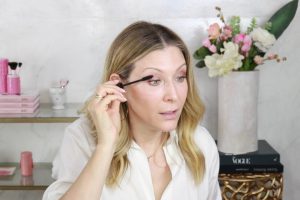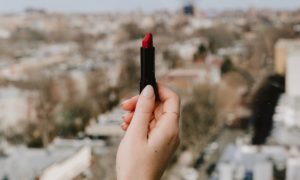Whether you’re a skincare newbie or have your routine down to an art, what’s *actually* happening on a micro level with your complexion can still be mysterious. What exactly is that retinol doing in there anyway and where, really, is that vitamin C serum working its magic? Learning the 411 about the largest organ on your body — your skin — can give you a better understanding of and appreciation for everything it does and, of course, inform how you take care of it.
Skin serves a lot of functions, but one stands out among the rest. “First and foremost, the skin is a barrier,” says NakedPoppy research scientist Marisa Plescia. “It is a physical barrier that keeps toxins and microorganisms out and prevents water loss from the body. It also provides photo-protection from UV rays and temperature regulation.”
To accomplish all of that, skin is made up of stacks of several layers — and not all are created equal. Each layer has its own purpose. To put it into practice, we’re going to track a popular ingredient, hyaluronic acid, as we walk through each layer; since it comes in a variety of molecular weights, it has the ability to reach various layers of skin. Speaking of, here’s a bird’s eye view of what we’ll be walking through:
- Microbiome
- Acid Mantle
- Epidermis
- Stratum corneum (a.k.a. the lipid barrier)
- Stratum granulosum
- Stratum spinosum
- Stratum basale
- Dermis
- Hypodermis, or subcutaneous layer
With that, let’s get into the science and how to apply it for your healthiest, glowiest skin.
The Skin Barrier
Let’s start at the top, the skin barrier. “The microbiome, acid mantle, and lipid barrier act as the three functioning components of the skin barrier,” says NakedPoppy skin specialist Tara Parenti. “The skin barrier is the outermost layer of the epidermis, which is the thin, outer layer of skin visible to the eye, protecting our body.”
The microbiome and acid mantle both lie above your physical skin. The microbiome, for the uninitiated, is an ecosystem of microorganisms — think bacteria, fungi, and viruses — that acts like the first line of defense against pathogens and microbes, according to Parenti. “It works closely with and is dependent upon the acid mantle,” she says.
The acid mantle, meanwhile, sits just under the microbiome and is made up of sweat and sebum. With its acidic level of 4.5 to 5.5 pH, the acid mantle is what gives skin its acidic pH — which, by the way, is essential for keeping the microbiome healthy. Basically: You can’t have one without the other.
Next up is the lipid barrier, a.k.a. the stratum corneum. That microbiome and acid mantle are key to its integrity. “When the microbiome and acid mantle are compromised, the skin barrier is left exposed and vulnerable,” says Parenti.
This is the uppermost level of your epidermis, which is the outer layer of skin. “The stratum corneum is the key to the epidermis,” says Plescia. “It consists of nine to 20 layers of flat cells called corneocytes.” These are dead cells, and they’re surrounded by lipids, such as ceramides, cholesterol, and free fatty acids.
Another way to think about it: Those dead cells are the “bricks” embedded in layers of those lipids, which serve as the “mortar.” The primary purpose of the stratum corneum is to seal water into skin and minimize trans-epidermal water loss (the process through which water evaporates from skin). Caring for it properly is the secret to truly radiant skin — more on that below.
Hyaluronic acid tracker: When you’re applying a product that contains hyaluronic acid, it can just go past the microbiome, acid mantle, and lipid barrier in order to sink into skin. Easy!
The Epidermis
We already touched on the top of the epidermis, which is the stratum corneum. There are three other layers here: stratum granulosum; stratum spinosum; and, at the very bottom, stratum basale. You don’t need to know much about these — except that keeping them healthy and happy (with the tips below) will help put smooth, soft skin within reach.
What’s also important is understanding the different types of cells that live here, all of which contribute to the healthy function of skin.
Here’s a quick overview:
- Keratinocytes: The main cell of the epidermis, these are in charge of producing the protein keratin, which helps adhere cells to each other and helps to form a protective layer of the skin.
- Melanocytes: These cells make melanin, the pigment of the skin, and are responsible for skin, hair, and even eye color. (Fun fact: Vitamin C interferes with melanocytes’ melanin production process, which can help fade and prevent dark spots.)
- Langerhans cells: These cells help the immune response and help protect skin and the body from pathogens.
- Merkel Cells: These cells live in the base layer of the epidermis and are responsible for light-touch stimuli.
The stratum basale, as we mentioned, is the lowest layer of the epidermis; this is where keratinocytes are born, and where melanocytes live and function, says Parenti. Those keratinocytes kick off the cycle that allows cells to shed and renew. “Keratinocytes make their way up each layer, going through various different processes and changes, and finally making up the stratum corneum and eventually shedding off,” she explains. “As soon as a layer sheds, this is signaled down below and the process starts all over again.”
While cellular turnover happens naturally, it can slow down over time. That’s where exfoliation can help, sloughing off old, dead skin cells and stimulating renewal in the process.
Hyaluronic acid tracker: Bigger sizes of hyaluronic acid are too large to get any further than the epidermis. But they can still do good here. “In the epidermis, hyaluronic acid provides a hydrating barrier and has more of a short-term, but often instantly visible, effect,” says Plescia.
The Dermis
Meet the main support system of the skin. “The dermis sits below the epidermis and above the subcutaneous layer, or hypodermis,” says Parenti. There’s a lot happening in this layer, from blood flow to skin structure to oil-producing sebaceous glands.
In many ways, this is where the magic happens. “The dermis provides the skin with mechanical strength, along with being the area of the skin with the main blood supply to keep the skin cells nourished and healthy,” says Plescia. You’ll find fibroblasts in the dermi, which produce collagen and elastin — a.ka. skin’s “scaffolding.” (The difference? Collagen gives skin strength and structure, while elasticity gives the skin “elasticity,” or stretch and flexibility.)
Hydration happens here, too. “The dermis also contains additional cells and components such as glycosaminoglycans, which are water-binding molecules which help provide hydration to the skin,” says Plescia. Hyaluronic acid is one of these, by the way.
Hyaluronic acid tracker: Smaller hyaluronic acid molecules — those that have a smaller molecular size — are able to reach the dermis. That’s the goal, at least, because it can deliver real benefits. Here, says Plescia, “hyaluronic acid can deliver long-term effects such as intense hydration, providing long-lasting results of plump, firm, and smooth skin.”
How to Care for Skin from Top to Bottom
Caring for the Skin Barrier
Keeping the skin barrier is all about minimizing the things that can harm it. “Avoid over-cleansing and over-exfoliating,” says Parenti, who also recommends using pH-balanced products. Additionally, using cleanser and moisturizer tailored to your genetic skin type can also make or break the health of the skin barrier. We’ve made it easy with the 3-minute NakedPoppy assessment, which can offer personalized recommendations.
And, of course, “keeping skin hydrated is key to healthy skin and a healthy skin barrier,” says Plescia. The key components of a good moisturizing routine are humectants, emollients, and occlusives; get all of the above by pairing a humectant, like the hyaluronic acid in Tata Harper Hyaluronic Gel Moisturizer, with a face oil, such as NakedPoppy Revitalize Organic Facial Oil.
Lifestyle tweaks can go a long way, too. Daily use of sunscreen is key, rain or shine, and a humidifier can help keep the skin barrier robust even in dry winter months.
Caring for the Epidermis
Free radicals caused by sun exposure and pollution can wreak havoc on the epidermis, which is where antioxidants, such as vitamin C, can come in handy; as a refresher, they neutralize those free radicals, putting them out of commission, and then work to repair any damage. (You can find a host of them in Indie Lee Daily Vitamin Infusion.)
Since melanocytes live on this level as well, brightening ingredients like niacinamide, arbutin, and kojic acid can keep them from working overtime, thus improving the appearance of dark spots. So — while the skin barrier is busy with hydration, the epidermis is your go-to for concerns like hyperpigmentation.
Caring for the Dermis
Since it’s the deepest layer of skin before reaching subcutaneous fat — which essentially serves as padding — the dermis can be hard to reach. But as collagen and elastin are on this level, doing so can have serious benefits. Retinol can be a gamechanger; for the uninitiated, this form of vitamin A can spur cell turnover and kickstart collagen production, which can restore structure to skin. That makes it worth using at any age, but particularly once you reach your 40s, which is around the time collagen synthesis begins to slow. Maya Chia The Straight A Serum pairs a clean form of retinol with natural retinol alternatives for double the perks.
Bottom line? Yes, skin is incredibly complicated. But understanding how each layer works can ultimately help you make the most of it. That can help keep skin healthy both now and in the years to come — after all, knowledge is power.






Comments